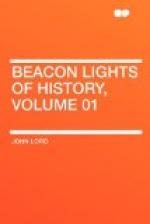It is probable also that Art was manifested to a high degree in the conversation of the Greeks, as they were brilliant talkers,—like Brougham, Mackintosh, Madame de Stael, and Macaulay, in our times.
But I may not follow out, as I could wish, this department of Art,—generally overlooked, certainly not dwelt upon like pictures and statues. An interesting and captivating writer or speaker is as much an artist as a sculptor or musician; and unless authors possess art their works are apt to perish, like those of Varro, the most learned of the Romans. It is the exquisite art seen in all the writings of Cicero which makes them classic; it is the style rather than the ideas. The same may be said of Horace: it is his elegance of style and language which makes him immortal. It is this singular fascination of language and style which keeps Hume on the list of standard and classic writers, like Pascal, Goldsmith, Voltaire, and Fenelon. It is on account of these excellences that the classical writers of antiquity will never lose their popularity, and for which they will be imitated, and by which they have exerted their vast influence.
Art, therefore, in every department, was carried to high excellence by the Greeks, and they thus became the teachers of all succeeding races and ages. Artists are great exponents of civilization. They are generally learned men, appreciated by the cultivated classes, and usually associating with the rich and proud. The Popes rewarded artists while they crushed reformers. I never read of an artist who was persecuted. Men do not turn with disdain or anger in disputing with them, as they do from great moral teachers; artists provoke no opposition and stir up no hostile passions. It is the men who propound agitating ideas and who revolutionize the character of nations, that are persecuted. Artists create no revolutions, not even of thought. Savonarola kindled a greater fire in Florence than all the artists




